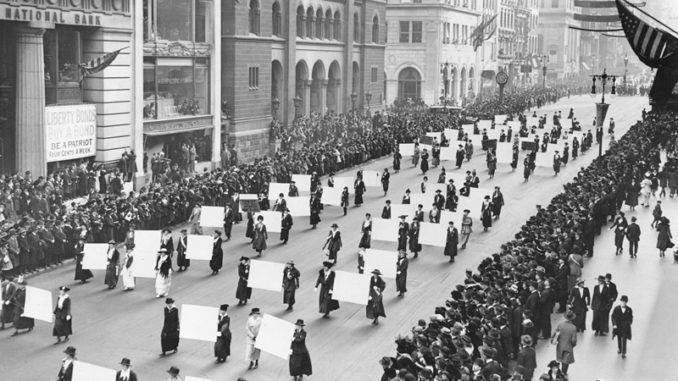
Cherry Sokoloski
The last battles of the women’s suffrage movement were dramatic – and even bloody at times. That time in the early 20th century was similar to a football team on the first-yard line, trying to score. The offense tries to scratch and claw its way over the line, while the defense uses all its strength and strategy to deny a touchdown.
So it was with women’s suffrage. It’s good to point out that women were not “given” the vote, nor were they “granted” the vote. They had to fight every inch of the way.
In the July and August articles, we look at the final struggle for Congressional approval of the 19th Amendment, and the two competing strategies that, together, won the day.
Thousands of women devoted themselves to getting women’s suffrage over the finish line, but two especially stand out: Carrie Chapman Catt (1859-1947) and Alice Paul (1885-1977). The two women fought tirelessly for the same end, but they couldn’t have been more different in the strategies they used.
This month, we’ll focus on Catt, a gifted speaker, and organizer. Raised in Iowa, Catt worked her way through college, since her father didn’t think higher education was necessary for women. She graduated from Iowa State Agricultural College in 1880, the only woman in her class.
Catt worked as a teacher and later became superintendent of schools in Mason City, Iowa, the first woman to hold that post.
In the 1990s, Iowa State University named a campus building after its famous alumna. The move was controversial, however, since Catt was not immune from the racism of her time – especially when trying to woo Southern senators to the suffrage cause.
Catt devoted more than 30 years of her life to women’s suffrage, serving twice as president of the National American Woman’s Suffrage Association. Unlike Alice Paul and other younger women, she preferred to work within the establishment; she was polite and ladylike. She founded local suffrage chapters nationwide and worked on numerous state suffrage campaigns, believing that as more women voted in the states, the federal goal would be easier to achieve. She called that strategy her “Winning Plan.”
For several years, she also led the International Woman Suffrage Alliance.
New York Victory
One important victory for Catt was the campaign for suffrage in New York State. Catt organized a huge parade in New York City, and her cadre of activists undertook an effort to reach every household in the state with their message.
The successful vote in November of 1917 was a huge milestone for the cause.
The New York campaign was considered “the Gettysburg of Suffrage,” in that it turned the tide but didn’t end the war. Some New York politicians even jumped on the women’s suffrage bandwagon during this campaign, sensing a shift in the winds that could affect their own reelection chances.
Since Catt wanted the country to adopt a constitutional amendment, she worked hard at the federal level, too. She cultivated a friendly relationship with President Woodrow Wilson, who had long resisted women’s suffrage. “Who is going to make the home, if the women don’t?” he once asked.
When the United States entered World War I in April 1917, Catt pledged NAWSA’s loyal support to Wilson. She organized an army of women to help with the war effort on many fronts, including support for the Red Cross and selling Liberty Bonds. This, despite the fact that Catt was actually a strong pacifist.
Women took over jobs vacated by men, working in munitions factories and farming the land. They also served overseas as nurses and ambulance drivers. Catt was sure that the women’s war efforts would sway the president and earn them the right to vote.
In fact, these wartime contributions did make an impact on public opinion and the president. There were other persuasive factors as well, orchestrated by Alice Paul and her more radical allies; we will take a look at those in next month’s article.
The shift in public opinion, plus the political fact that women could already vote for president in 18 states, finally persuaded President Wilson to change his mind about women’s suffrage. He announced his support for the 19th Amendment on Jan. 9, 1918. The next day, the U.S. House of Representatives voted in favor of the amendment, but it took another year and a half before the U.S. Senate passed the measure.
Even that was not the end of the story. The 19th Amendment still had to be ratified by 75 percent of the states – which at that time was 36 states. The tireless Catt worked on this year-long effort as well.
When women finally had the vote, there was no longer a need for a national suffrage organization, so the NAWSA morphed into the League of Women Voters. Catt had a hand in that, too.
Sources: Great Women of the Suffrage Movement by Dana Meachen Rau, 2006; PBS documentary “The Vote”.
Support Northern Colorado Journalism
Show your support for North Forty News by helping us produce more content. It's a kind and simple gesture that will help us continue to bring more content to you.
BONUS - Donors get a link in their receipt to sign up for our once-per-week instant text messaging alert. Get your e-copy of North Forty News the moment it is released!
Click to Donate
